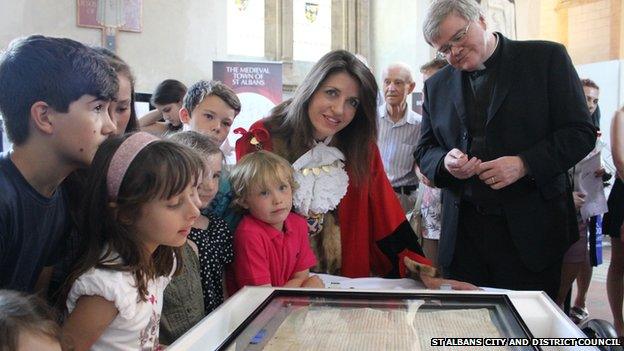St Albans celebrates Magna Carta link
- Published

The dean of St Albans Cathedral, the very Reverend Dr Jeffrey John and mayor Annie Brewster welcomed the Magna Carta to the city on Friday
Exactly who said what at a meeting in St Albans almost exactly 800 years ago is lost in the mists of time.
But the gathering is generally agreed by historians to have shaped one of the most important documents in English history, the Magna Carta.
On 4 August 1213, St Albans Abbey hosted the first gathering between barons and the clergy, led by Archbishop of Canterbury Stephen Langton, to discuss their grievances against King John.
It was two years later, in Runnymede, when the king signed an agreement which set out the principles of freedom under the law and sought to limit his power.
'Birth of red tape'
This month, two years before the rest of the UK celebrates its 800th anniversary, one of the four remaining original copies of the historic charter is on display in St Albans, Hertfordshire's only city, to mark this key event in the run-up to the 1215 agreement.
David Thorold, curator of the medieval collections at St Albans Museums, said the meeting was one of a series which sought to try to limit the power of the monarch, who had "pushed the absolute power of the king further than anybody else had pushed it before".
"John would change his mind on a whim if he saw a benefit for him and, just when barons thought they would have a deal with the king, all of a sudden they'd find everything upturned," he said.
"The meeting [in St Albans] put forward the fairly new idea of actually having a codified written law, a series of rules that the king was held by."
Mr Thorold said that while charters had been written before, it was usually after the event, and relied on accurate memory.
These discussions marked the start of a two-year process and in 1215, at Runnymede, the king signed the charter, a series of rules designed to try to make him operate along set lines.
"In a sense, the Magna Carta was really the birth of bureaucracy - the start of red tape," he said.
The curator said that while it failed in its initial purpose, as "John simply signed it and then found a way out of the deal that he had made", the 1215 charter was not forgotten.
New versions were written and John's son, Henry III, signed a version in 1225 which is still referred to today.
Mr Thorold said it was "very apt" for the city to host the Magna Carta.
'Strangely moving'
"It's a reminder that, at the time, St Albans was a significant player in these sort of events, it was a place where the elite came to to discuss things, it was a conference centre of its day," he said.
"It was like the presidents of America and Russia getting together, the main events on the political stage were being played out in and around the city."
There are only four copies of the original 1215 Magna Carta still in existence - at Salisbury Cathedral, in Lincoln Castle and two at the British Library in London.
Lincoln's copy is now on loan to St Albans Cathedral until 29 August, and is accompanied by an exhibition at the Museum of St Albans which runs until mid-September.
An Abbey spokeswoman said so far they had sold about 3,000 tickets to see the charter, priced between £3 and £4.
The dean of St Albans Cathedral, the very Reverend Jeffrey John, said there was something "strangely moving" about welcoming it to the place where it all began.
"The long queues waiting to see the Magna Carta testified to the way in which the significance of this small document has caught the imagination of the public," Dr John said.
- Published30 May 2013
- Published21 March 2013
- Published28 October 2012
- Published23 October 2012
- Published27 September 2012